COURSE OUTLINE 13
- GENERAL
| SCHOOL | SOCIAL, POLITICAL AND ECONOMIC STUDIES | ||||
| SECTION | SOCIAL POLICY | ||||
| LEVEL OF STUDIES | LEVEL 6 | ||||
| COURSE CODE | 13 | SEMESTER OF STUDY | 1st | ||
| COURSE TITLE | Introduction to Informatics | ||||
| INDEPENDENT TEACHING ACTIVITIES where credit is awarded for discrete parts of the course e.g. lectures, laboratory exercises, etc. If credit is awarded for the whole course, indicate the weekly teaching hours and the total number of credits |
TEACHING WEEKS | CREDIT UNITS | |||
| 3 | 6 | ||||
| Add rows if necessary. The teaching organisation and the teaching methods used are described in detail in 4. | |||||
| TYPE OF COURSE
Background , General Knowledge, Scientific Area, Skills Development |
Skills Development | ||||
| PREREQUISITE COURSES:
|
– | ||||
| LANGUAGE OF TEACHING AND EXAMINATION: | GREEK | ||||
| THE COURSE IS OFFERED TO ERASMUS STUDENTS | YES | ||||
| ELECTRONIC COURSE PAGE (URL) | https://eclass.duth.gr/courses/438189/ | ||||
- LEARNING OUTCOMES
| LearningOutcomes | ||
| The learning outcomes of the course are described as the specific knowledge, skills and competences of an appropriate level that students will acquire after successful completion of the course.
ConsultAnnex A · Description of the Level of Learning Outcomes for each cycle of study according to the Qualifications Framework of the European Higher Education Area · Descriptive Indicators for Levels 6, 7 & 8 of the European Qualifications Framework for Lifelong Learning and Annex B · LearningOutcomesWritingGuide |
||
| The students who will attend this course will gain a first contact with the basic principles of the information technology and the Internet, their applications and services, as well as with the main milestones of the evolution of computer technologyto date. The students will get familiar with the theoretical concepts of information collection, data organization and analysis. Additionally, they will be aware of the most important challenges of modern informatics, such as ethics in artificial intelligent, social computing, protection of personal data, fake news on the Internet and the impact they have on themodern society.The aim of the course is toallow the participants to be active users of the computing technologies and the services they offer, to facilitate the understanding of social phenomena. Additionally, it contributes to the developmentof a critical thinking with regards to the impact of the latest developments in informatics on the social reality. | ||
| General skills | ||
| Taking into account the general competences that the graduate should have acquired (as listed in the Diploma Supplement and listed below), which one(s) does the course aim at? | ||
| Search, analysis and synthesis of data and information, using the necessary technologies
Adapting to new situations Decision-making Autonomous work Teamwork Working in an international environment Working in an interdisciplinary environment Generating new research ideas |
Project planning and management
Respect for diversity and multiculturalism Respect for the natural environment Demonstrate social, professional and ethical responsibility and sensitivity to gender issues Exercise of criticism and self-criticism Promoting free, creative and inductive thinking |
|
| · Data collection, analysis and visualizationbased onsoftware tools.
· Preparation of individual or group project. |
||
- COURSE CONTENT
| The course focuses on familiarizing students with the basic concepts and applications of the information technologies. It begins with a brief historical review of some critical moments in the development and evolution of technology. Then, it focuses on the basic theoretical concepts of data collection, analysis, and visualization. Finally, it examines the influence of technology and the impact of the latest developments of information and computing technology in all the areas of life at individual, social and global level. The course does not require – although it is facilitated by – computer literacy.
Indicative concepts:
|
- TEACHING and LEARNING METHODS – EVALUATION
| METHOD OF DELIVERY Face-to-face, Distance learning, etc. |
Face to face | ||||||||||||||||||||
| USE OF INFORMATION AND COMMUNICATION TECHNOLOGIES Use of ICT in Teaching, Laboratory Training, Communication with students |
· Spreadsheet and database management software tools for demonstration during the courses
· PowerPoint presentation material |
||||||||||||||||||||
| ORGANISATION OF TEACHING
The way and methods of teaching are described in detail. Lectures, Seminars, Laboratory Exercise, Field Exercise, Study & Analysis of Literature, Tutoring, Practical (Placement), Clinical Exercise, Artistic Workshop, Interactive teaching, Educational visits, Study visits, Project work, Writing work / assignments, Artistic creation, etc.
The student’s study hours for each learning activity and the hours of unguided study are indicated so that the total workload at semester level corresponds to the ECTS standards. |
|
||||||||||||||||||||
| STUDENT ASSESSMENT
Description of the evaluation process
Language of Evaluation, Evaluation Methods, Formative or Inferential, Multiple Choice Test, Multiple Choice Test, Short Answer Questions, Test Development Questions, Problem Solving, Written Work, Report, Oral Examination, Oral Examination, Public Presentation, Laboratory Work, Clinical Examination of a Patient, Artistic Interpretation, Other
Explicitly identified assessment criteria are stated and if and where they are accessible to students. |
The final evaluation shall take into account: 1) The preparation of a project. 2) The final written examination.
Preparation and presentation of projects: Data collection, analysis, and visualization, using state of the art software tools. The originality of the means of presentation, the interactivity,and the completeness of the analysis of the topics are evaluated.The use of ICT isessential in the presentation. |
- RECOMMENDED-BIBLIOGRAPHY
| Alan Evans, Kendall Martin, Mary Anne Poatsy, (2018). Introduction to Computer Science-Theory and Practice 2nd edition, Athens, Greece: Critique |
 Ο Πρόεδρος και τα μέλη του Διδακτικού Προσωπικού καλωσορίζουν τους νεοεισαχθέντες φοιτητές του Τμήματος.
Ο Πρόεδρος και τα μέλη του Διδακτικού Προσωπικού καλωσορίζουν τους νεοεισαχθέντες φοιτητές του Τμήματος.
